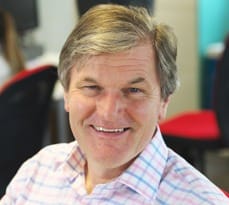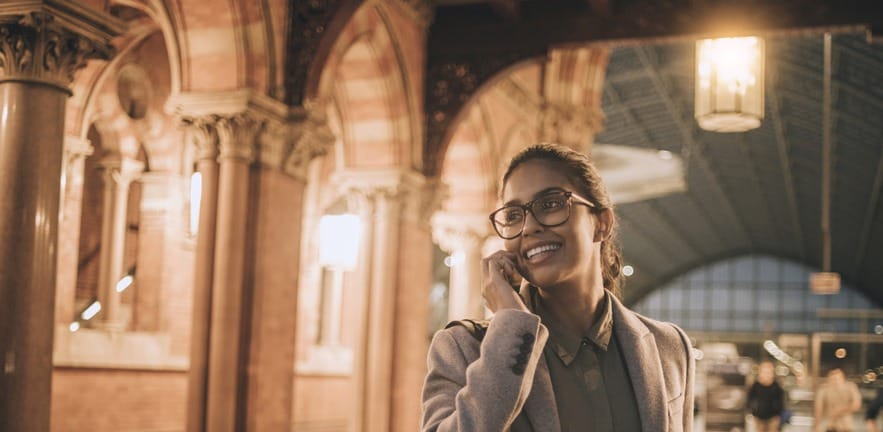
Anyone who has tried to hold a mobile phone conversation on a noisy train knows how frustrating it can be when the other person’s voice fades in and out, or there is static, or words seem mumbled due to poor reception in and around tunnels.
This sort of mobile phone experience can too often be the norm for people with hearing loss – which inspired Matthew Turner to launch the venture Goshawk Communications, which tailors a mobile phone signal to an individual’s specific hearing impairment or needs. Goshawk is a startup from the first cohort of the Cambridge Social Ventures programme at the Cambridge Centre for Social Innovation at Cambridge Judge Business School.
Matthew, who has been hard of hearing since childhood, worked in corporate finance and other business roles in Europe and the US before launching Goshawk in 2012. During his international career, he has often struggled to communicate on the phone – and that’s why he’s passionate about finding a solution.
According to Action on Hearing Loss, more than 10 million people (about one in six) in the UK have some degree of hearing impairment or deafness. And research funded by the Bill & Melinda Gates Foundation suggests that there are around 1.5 billion people globally with hearing loss.
“Poor product design, call signal and service quality has left people with hearing loss feeling ‘isolated’, ‘tired’ and ‘nervous’ – these are just few responses we got to Goshawk’s survey about difficulties people face when using the phone,” says Matthew. “We have a simple yet novel solution to this problem – effectively a hearing aid in the sky.”
This is not an app, but an integrated software service within the core mobile phone network to ensure it is “technology agnostic” – able to receive any call from any device.
Goshawk Communication’s software is designed to enhance an audio signal so it is personalised to the individual mobile phone customer’s needs – with plans to extend this to fixed line phones in the future. The first step is to do a hearing test in order to identify the level of hearing impairment – as some people have difficulties with high frequencies, and others with low frequencies. The data is then saved in the cloud and stored in the telecoms network. The system “remembers” the customer’s number – and every time someone calls, the voice of the caller is adjusted to the customer’s hearing level. The call is delivered through standard mobile phone technology, and doesn’t require any additional device or accessory.
Goshawk had promising results from an initial trial of the device, funded by the charity Wellcome Trust, which involved the Isle of Man’s Department of Health and Social Care’s Audiology Service in collaboration with Manx Telecom.
Goshawk’s technology was deployed on the Manx Telecom mobile network, and participants who received digitally enhanced telephone calls were asked to compare these with calls they made without the Goshawk system. Feedback from participants showed that when the network is operating efficiently and signal quality is good, those with mild to severe hearing loss can benefit from enhanced call quality and speech intelligibility.
“The sound was clearer across the range and I didn’t need to keep asking ‘what did you say?’ or have to pretend to hear them or to try to fill the blanks, said participant Nigel Dempsey Moore. “It really made a difference. I could hear in the wind and I could hear people speaking fast.”
The director of the non-profit organisation Ideas for Ears, Sally Shaw, was involved in monitoring experiences of trial participants. She said: “For most of the trial participants there was a marked improvement in the clarity with which they could hear and for some it entirely transformed the way they could use their mobile phone. Participants didn’t have to use their hearing aid at all, as the modified sound was of sufficient clarity and volume to allow them to put the phone straight to their ear.”
Looking ahead, Matthew has now launched a larger second trial on the Isle of Man, and hopes to roll out in the UK later this year.
He said the main challenge at the moment is to ensure a robust system compatible with the Quality of Service requirements for a core network operator, which will require some additional R&D in handling call flow requirements.
Working with Manx Telecom subsidiary Vannin Ventures Matthew is planning to commercialise the service and launch in the summer of 2017 where potential users may benefit from subsidies through the UK Government’s Access to Work programme.
Matthew is interested in hearing from…
…anybody interested in what Goshawk Communications is doing and in particular from those with hearing loss or specific hearing needs as to what their own experiences are.
This article is part of Venturing Forth, our new series on the aspirations and challenges of ventures connected to students, alumni and others associated with Cambridge Judge Business School.


